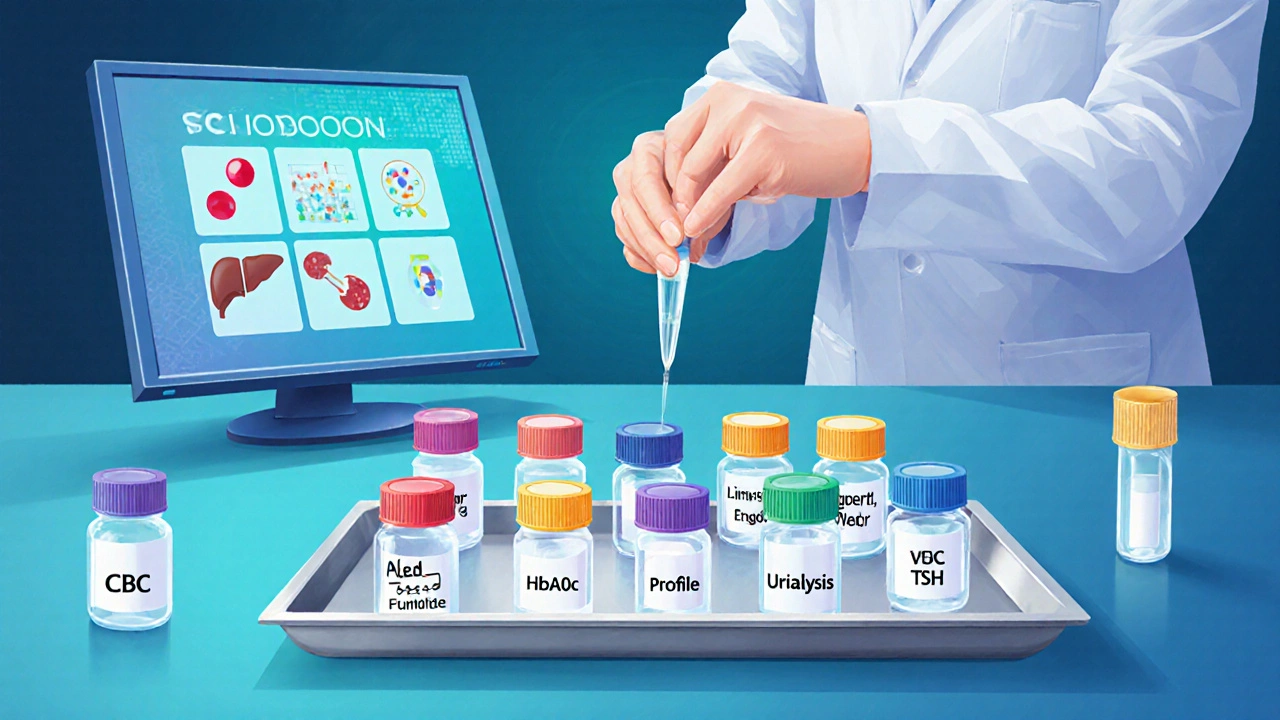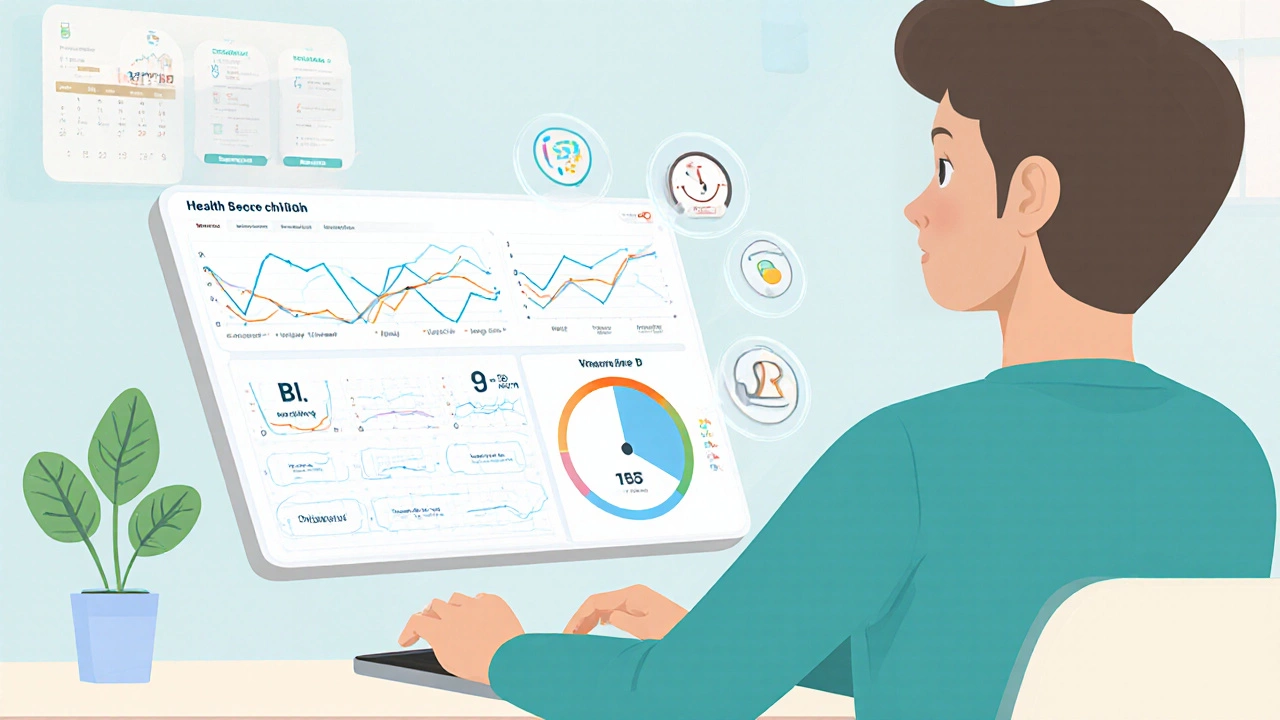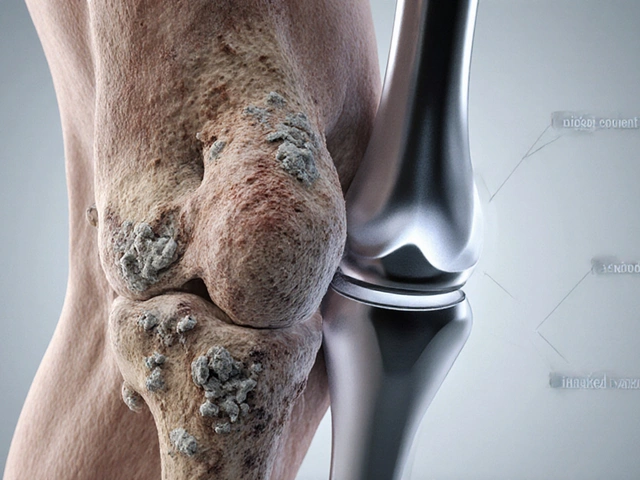Health Screening Frequency Calculator
Personalized Health Screening Calculator
Get recommendations for which tests you should have and how often based on your age, health status, and risk factors.
Your Personalized Screening Plan
Important Note: This tool provides general guidelines. Always consult with your healthcare provider for personalized medical advice.
When you hear people talk about a "check‑up," they’re usually picturing a quick glance at blood pressure and a few lab results. But if you really want a single test-or a set of tests-that tells you how your body is doing from head to toe, you need a more strategic mix of lab work and physical measurements. Below we break down the most informative tests, how they fit together, and how often you should repeat them to stay ahead of hidden problems.
Key Takeaways
- A combination of blood panels, urine analysis, and simple physical metrics gives the most complete picture of health.
- The best health test isn’t a single lab; it’s a core set that includes CBC, CMP, lipid profile, HbA1c, thyroid, vitamin D, and urinalysis.
- Physical checks-blood pressure, BMI, and a brief physical exam-anchor the lab data and catch issues labs can miss.
- Adults with no chronic conditions should repeat the core panel every 2‑3 years; high‑risk individuals may need annual testing.
- When choosing a screening package, look for test breadth, reputable labs, and clear follow‑up recommendations.
What "overall health" really means
Overall health isn’t just the absence of disease; it’s the balance of metabolic function, cardiovascular fitness, hormonal stability, and organ integrity. Think of the body as a car: the engine, brakes, fuel system, and tires all need regular inspection. A lab test that checks only cholesterol leaves the fuel system unchecked, while a blood pressure reading alone doesn’t reveal engine wear. The best approach stitches together multiple data points into a single health dashboard.

Core lab tests that give a health snapshot
These seven tests are the backbone of any comprehensive screening. Each one targets a specific organ system or metabolic pathway, and together they flag anemia, kidney or liver stress, blood‑sugar control, heart‑risk factors, hormonal imbalances, and nutrient deficiencies.
Complete Blood Count (CBC) - measures red and white blood cells, hemoglobin, hematocrit, and platelets to uncover anemia, infection, and clotting disorders.
Comprehensive Metabolic Panel (CMP) - assesses blood glucose, electrolytes, kidney function (creatinine, BUN), liver enzymes, and protein levels, giving a quick read on organ health.
Lipid Profile - includes total cholesterol, LDL, HDL, and triglycerides; it’s the primary predictor of cardiovascular disease risk.
Hemoglobin A1c (HbA1c) - reflects average blood‑sugar levels over the past 2‑3 months, helping spot pre‑diabetes or uncontrolled diabetes.
Thyroid Stimulating Hormone (TSH) Test - checks thyroid function, which influences metabolism, mood, and energy.
Vitamin D (25‑OH) Test - measures the most reliable form of vitamin D; low levels link to bone health, immunity, and mood disorders.
Urinalysis - examines urine for glucose, protein, blood, and infection indicators, revealing early kidney or urinary tract issues.
| Test | Main Insight | Typical Frequency | Average Cost (USD) |
|---|---|---|---|
| CBC | Blood cell health, infection, anemia | Every 2‑3 years | 20‑40 |
| CMP | Kidney, liver, electrolytes, glucose | Every 2‑3 years | 30‑50 |
| Lipid Profile | Heart‑disease risk | Every 2‑3 years | 25‑45 |
| HbA1c | Long‑term blood‑sugar control | Annually if at risk | 35‑55 |
| TSH | Thyroid function | Every 5 years (or sooner if symptoms) | 25‑40 |
| Vitamin D | Bone & immune health | Every 2‑3 years | 40‑70 |
| Urinalysis | Kidney, infection, metabolic clues | Every 2‑3 years | 15‑30 |
Physical checks that complement lab work
Numbers from a lab tell you what’s happening inside; simple measurements tell you how the body is responding on the outside. These three checks are quick, cost almost nothing, and dramatically improve the interpretive power of the blood work.
Blood Pressure Measurement - captures systolic and diastolic pressure; high readings are the leading modifiable risk factor for heart attack and stroke.
Body Mass Index (BMI) Calculation - uses height and weight to estimate body fat; a BMI above 30 signals obesity‑related health risks.
Physical Examination - a brief doctor‑led review of heart, lungs, skin, and joint health that can reveal clues labs miss, such as heart murmurs or skin lesions.
How often should you get these tests?
Frequency depends on age, family history, lifestyle, and existing conditions. Below is a practical schedule you can customize.
- Age 20‑39, no chronic issues: Full core panel (CBC, CMP, lipid, TSH, vitamin D, urinalysis) every 3years; add HbA1c if BMI>25 or you have a family history of diabetes.
- Age 40‑59, moderate risk: Core panel every 2years; HbA1c annually; repeat vitamin D if you live in northern latitudes or have limited sun exposure.
- Age60+, or high‑risk groups (smokers, hypertensive, heart disease family history): Annual core panel, annual HbA1c, and yearly physical exam with blood pressure check.
Remember, any new symptom-fatigue, unexplained weight change, persistent pain-should trigger an earlier test, regardless of schedule.

Choosing the right package: what to look for
Many clinics bundle the core tests into a "wellness package" or "annual health screen." Not all bundles are equal. Here’s a quick checklist to compare offers:
- Test coverage: Does the package include all seven core labs plus blood pressure and BMI?
- Lab accreditation: Look for CLIA‑certified labs; they guarantee quality standards.
- Result turnaround: Faster reports mean quicker follow‑up. Online portals are a plus.
- Physician interpretation: Raw numbers are useful, but a qualified clinician’s summary helps you act.
- Cost transparency: Hidden fees for sample collection or report delivery can inflate price.
Putting it all together: building your personal health dashboard
Once you have the results, treat them like a personal dashboard. Use a spreadsheet or a health‑app to track trends over time:
- Enter each test’s numeric result and the date you received it.
- Highlight values that fall outside the standard reference range.
- Set reminders for the next scheduled test based on the timeline above.
- Note any lifestyle changes (diet, exercise, sleep) that coincide with improvements or declines.
- Review the dashboard with your physician at least once a year.
This habit turns a one‑time lab visit into an ongoing conversation with your own body.
Frequently Asked Questions
Do I really need all seven core tests?
Each test looks at a different organ system or risk factor. Skipping one can leave a blind spot-like missing early kidney stress because you never ordered a CMP. For a true health snapshot, the full set is the most reliable approach.
Can I get these tests done at a pharmacy?
Many large pharmacy chains now offer basic blood‑draw services, but they often partner with external labs. Verify that the lab is CLIA‑certified and that you’ll receive a physician’s interpretation, not just raw numbers.
What if a result is abnormal but I feel fine?
Abnormal labs can precede symptoms by months or even years. Follow up with your doctor for confirmatory testing and a tailored plan-diet, medication, or lifestyle tweaks.
Are there any risks to these screenings?
Risks are minimal-mainly a brief needle stick for blood draws and a small chance of false‑positive results. The benefits of early detection far outweigh these minor inconveniences.
How can I lower the cost of a full health screen?
Check if your insurance covers preventive labs; many plans cover the core panel once a year. Community health fairs and university clinics also offer discounted bundles.






